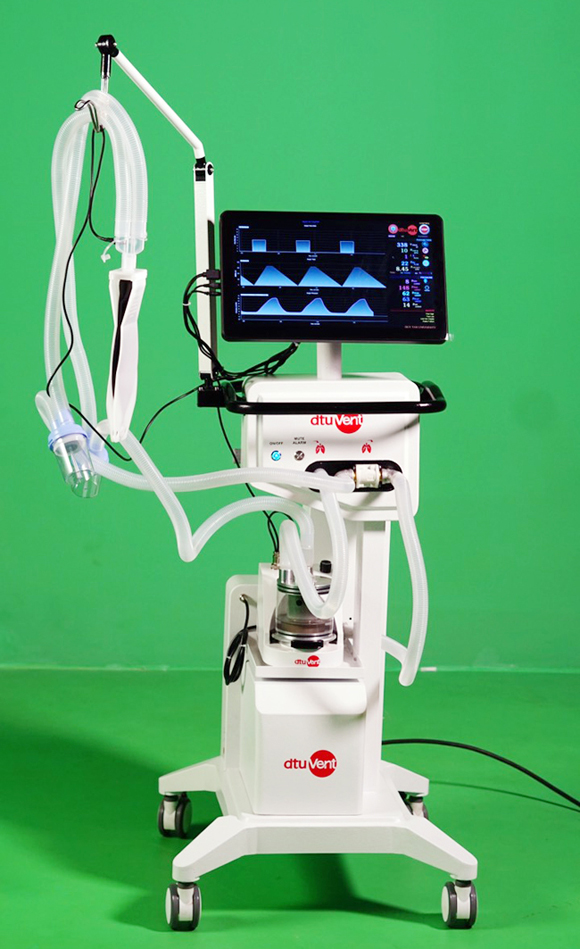
2-in-1 DTU-Vent version 3.0
The “2-in-1” DTU-Vent combined the functionalities of noninvasive and of invasive ventilators with many other capabilities, such as a touch panel for remote control, the possibility to operate and monitor many ventilators at once, and a warning system to ensure that doctors and nurses can deal with unusual developments in a timely fashion.
While the DTU-Vent version 1.0 only offered noninvasive ventilation, the versions 2.0 and 3.0 were designed to allow operation as an invasive ventilator to treat severe cases that need to breathe through an endotracheal tube.
The difference between the versions 2.0 and 3.0 is that version 2.0 is easily transported, while version 3.0 is a professional ventilator for use in hospitals with many high-level parameters.
This version of the ventilator can be used invasively to fully control the patient’s breathing, or it can be used noninvasively and just provide oxygen to the lungs at a fixed frequency through a nasal or a full face mask, responding quickly with large quantities of oxygen to stimulate breathing.
The DTU-Vent version 3.0 has many strengths, such as:
- a piston pump with highly stable and accurate air flow,
- a design based on AMMI-Covid-19 requirements,
- pumping volumes adjusted with high accuracy,
- maximum tidal volume was 450 ml in version 1.0 and is increased to 750 ml in version 3.0,
- maximum airflow speed was increased from 30 l/min to 120 l/min in version 3.0,
- positive end-expiratory pressure (PEEP) from 0 to 20 cmH2O (to avoid overloading the lungs) can be set through the software and is automatically controlled,
- fraction of oxygen (FiO2) can be adjusted from 21% to 100% (to provide sufficient oxygen to patients with different severity),
- pump noise frequency was reduced, ventilator noise levels are below 35 dB,
- air is humidified and its temperature stabilizes as it enters the body,
- warning signals ensure optimal safety when using the ventilator in conjunction with software for control and monitoring, to deal with issues like high or low pressure, insufficient oxygen capacity, and power failures, - less power consumption than other, piston-based, ventilator products available on the market,
- design is optimized to be independent of foreign providers of components.
DTU researchers focused on controller design, touch display, and on the possibility of fully functional remote control through the software installed on the ventilator and on a server.
These attributes help doctors and nurses avoid frequent close contact with their patients and permit continuous patient status monitoring in addition to the simultaneous control of many ventilators, which reduces pressure on medical personnel and saves doctors and nurses time and effort, especially with the current reemergence and spread of Covid-19.

Closeup of the DTU-Vent version 3.0
The DTU-Vent version 3.0 has ten preset regimes to be chosen based on a patient height estimate, which saves medical staff time and makes the ventilator easy to operate. The machine can function at many different regimes, such as pressure control, volume control, and assist control (providing necessary and instantaneous breathing support) depending on survival indicators of the patient.
“In this third version, we improved quite a lot of the functionality, working towards a machine that can be tailored to any respiratory distress situation,” Dr Le Hoang Sinh, leader of the DTU-Vent research group, explains. “We also developed a machine of which all settings can be adjusted through remote control software, such that doctors can operate it and monitor their patients remotely without close contact. This feature makes the machine specially suitable for treatment of Covid-19. We are doing research into the necessary procedures to receive inspection and to obtain a marketing permit. Our research group also hopes the DTU-Vent will soon be allowed on the market to contribute to the fight against Covid-19, which is now spreading rapidly and becoming a complex issue.”
(Media Center)
With their two initial versions, the DTU research group acquired the experience necessary to continue improving their DTU-Vent ventilator to version 3.0 with all the functionality of a professional medical ventilator, meeting the requirements for use in emergencies and to treat Covid-19 patients.
















